STANLEY KUBRICK'S A CLOCKWORK ORANGE
Shot-by-Shot Analysis
Part One

Go to TOC for this film ( (which has also a statement on purpose and manner of analysis and a disclaimer as to caveat emptor and my knowing anything authoritatively, which I do not, but I do try to not know earnestly, with some discretion, and considerable thought).
Malcolm McDowell - Alex
Philip Stone - Dad
Sheila Raynor - Mum
Patrick Magee - Mr. Alexander
Adrienne Corri - Mrs. Alexander
Warren Clarke - Dim
James Marcus - Georgie
Aubrie Morris - Deltoid
Godfrey Quigley - Prison Chaplain
Michael Bates - Chief Guard
Carl Duering - Dr. Brodsky
Madge Ryan - Dr. Branom
Miriam Karlin - Catlady
Stanley Kubrick - Screenplay based on Anthony Burgess' novel
Wendy Carlos - Music
John Alcott - Cinematography
Bill Butler - Film Editing
John Barry - Production Design
John Barry - Art Direction
USA release date 29 December 1971
Go to IMDB for full listing
TOC and Supplemental Posts | Part 1 | Part 2 | Part 3 | Part 4 | Part 5 | Part 6 | Part 7 | Part 8 | Films Home
LINKS TO SECTIONS OF THE ANALYSIS ON THIS PAGE:
Credits, Shots 1 through 3
On the "Funeral Music for Queen Mary" and blood as redemption. Mary's husband, William of Orange, and the Orange Lodge.
The Orange on Red
The Two Shades of Red
Introducing the Milk Bar and Alex and His Droogs, Shot 4
The Mannequin Furniture
Women as Portrayed in the Opening Scene
The Irish Bum, Shots 5 through 12
The Irish and orange. A glimpse of Alex's rage which distinguishes him from his peers.
The Subway Tunnel
The Casino, Shots 13 through 42
The famous theater of the Principality of Orange (Arauncio) and theatricality in A Clockwork Orange. "The Thieving Magpie". A ballet. A history of violence as condoned by the big heads.
From Himberama to Wonderama
Joyriding, Shots 43 through 51
The Durango.
The Joke in "Then We Headed West"
Home, Shots 52 through 78
The orange globe. The bookcases and the hidden blackboards. Singing in the rain and the secret singer. Burgess as the writer. Alexander and Alex.
The Great Bird, Shots 79 through 92
Kilroy. The Ode to Joy and brotherhood.
Lucy
On the Blackboards and Some Correspondences Between the Milk Bar, the Tunnel, and HOME
SKYBREAK, Mondrian and Opening Credits, Prison and Van Gogh
1 Red screen (00:03) Red screen.
The film opens with the great Wendy Carlos' title music. A curious sense of troubling majesty and anticipation is communicated. And well it should be. We are listening to Carlos' interpretation of Henry Purcell's "Funeral Music for Queen Mary" composed in 1695. This was its text.
Man that is born of a woman
hath but a short time to live,
and is full of misery.
He cometh up, and is cut down,
like a flow'r;
he fleeth as it were a shadow,
and ne'er continueth, in one stay.
In the midst of life we are in death,
of whom may we seek for succour
but of thee, O Lord,
who for our sins art justly displeased?
Yet, O Lord, O Lord most mighty,
O holy and most merciful Saviour,
deliver us not into the bitter pains
of eternal death.
Thou knowest, Lord,
the secrets of our hearts,
shut not Thy merciful ears unto our pray'rs;
but spare us, Lord most holy,
O God most mighty.
O holy and most merciful Saviour,
Thou most worthy Judge eternal,
suffer us not, at our last hour,
for any pains of death,
to fall away from Thee.
Spare Thy people
whom Thou hast redeem'd
with Thy most precious blood,
and be not angry with us for ever.
Spare us, good Lord.
The pitiful plight of terror for one's creator and judgment from which not even the Queen is exempt. "Spare thy people whom thou hast redeem'd with Thy most precious blood, and be not angry with us forever. Spare us, good. Lord."
The choice of funereal music and its prayer are significant. The Shining will open with the same plea for compassionate judgment and mercy in its use of the Dies Irae music.
Though the screen is bright red, we've immediately a connection with "orange" through Queen Mary to whom this music is dedicated. Wikipedia used as source, she lived 1662 thru 1694, still a young woman when she died. She and her husband, the Dutch prince, William III of England (1650-1702), the Duke of York and Albany, were Protestant, and she ruled with him following the "Glorious Revolution" during which her father, James, a Roman Catholic, was deposed. William was also known as William of Orange, the title of Orange associating him with the Principality of Orange in southern France. The modern Orange Institution/Orange Order/Orange Lodge, a Protestant fraternal organization, is a tribute to William and his defeat of the Catholic army of James II (Mary's father, an autocrat, had advocated religious tolerance first in England then Ireland) at the 1690 Battle of the Boyne. Wikipedia states, "Politically, the Orange Institution is strongly linked to British unionism. Observers have accused the Institution of being sectarian, triumphalist and supremacist." A goal in their founding was to hinder Irish nationalists and uphold the "Protestant Ascendancy" in Ireland. The United Irishmen, though led by Protestants, desired to unite all faiths, and the government had hopes the Orange Order would thwart this fomenting sectarianism and disorder under a pretense of "passion for the Protestant religion..." The basis of the Orange Order is promotion of biblical Protestantism and British unionism.
The Orange Order was against home rule in Ireland. From 1921 to 1969 every Prime Minister of Northern Ireand was an Orangeman. In 1969 was the outbreak of "The Troubles", a period of intense conflict. The Orangemen were encouraged to join the Northern Ireland security forces. They also joined loyalist paramilitaries and have been distinguished as not dissimilar from the KKK.
And there's your Orangemen in a capsule.
A Clockwork Orange was released in 1971 and Kubrick soon thereafter withdrew it from being viewed in the UK due to death threats against his family. That's one story. I've also read instead he withdrew it because of a couple of assaults against others that had elements of the droogs to them.
Burgess gave several possible origins for the possible meaning of A Clockwork Orange. Most often expressed is the organic human operating mechanically, and we find this in Kubrick's film, just as we find in all his films the struggle of predestination with free will, but I do wonder if Kubrick took the opportunity to layer in allusions to the Orangemen and the the unrest of the time. Nowhere in Burgess' book is an Irishman explicitly mentioned, but the first assault in the film is against an old Irishman singing "Sweet Molly Malone."
1a WARNER PROS. A Kinney Company Presents (00:29)
This could be very well shot 2, but I'm holding with shot 1 as the red color of the screen doesn't change.
2 Blue screen. A STANLEY KUBRICK PRODUCTION (00:34) Blue screen. A Stanley Kubrick Production.
3 Red screen. A CLOCKWORK ORANGE (00:40) A brighter red screen. A Clockwork Orange.
In 1971, these brilliant, color-block titles were aggressive, in-your-face and wild. A shock to the system on the big screen, especially accompanied by the synth scoring of the Purcell. They held an aura of violence to them, while at the same time being artistic and with a peculiar hint of the cartoon. On the big screen, I doubt much of this effect would be lost today, but is not as evident on the small screen.
There is also some immediate conflict with A Clockwork Orange appearing on a bright red screen. We read orange. We expect the color orange. Instead we see red. And the brain is already trying to deal with "Just what does Clockwork Orange mean?"
Why these two shades of red at the film's beginning--one dark and one bright? I'll approach that question later but I wanted to make note of the two shades here, that they are important and occur paired and in contrast with one another at various points in the film.
Though it is criminal to spill blood, paradoxically, a number of religions communicate redemption not through goodness but blood sacrifice, death, and rebirth. The film approaches the problem of redemption through blood bound up with religion, even opening with this via the "Funeral Music for Queen Mary".
Spare Thy people
whom Thou hast redeem'd
with Thy most precious blood,
and be not angry with us for ever.
Spare us, good Lord.
4 CU Alex (00:48)
Cut to the so very famous shot of Alex resting against a black wall, staring at the camera, dressed out in his black bowler and black eyelashes ornamenting his right eye (screen left). In his breathing seems a barely restrained violent passion yet he is also half-smiling at us. Again, conflict. We see a smile, we feel threat. The camera pulls back (1:04) showing Alex is sitting in the midst of his gang who wear a uniform of white shirts, white trousers, white suspenders, black boots. Georgie Boy, who will eventually be a contender to Alex's throne, sits to the right of the screen. Dim, the idiot, sits to screen left and beside him is Pete.
Alex's shirt cuffs are decorated with bloodied globular eyeballs. Georgie's shirt is ornamented in the breast area with seeming nipple-like elements with sharp tacks through them. Red decorative elements of blood gore are on Dim's suspenders.
They sit beneath the words Moloko Vellocet in the milk bar, their drugged milk drinks in hand. A mannequin table before them of two nude white women, Alex nonchalantly rests his feet upon them. We see other such table mannequins in wigs as the camera pulls back further, and if one reflects on it a moment one realizes that these mannequin-tables are impractical for anything but footrests, a couple of them having a glass placed on the breast just before the chin but that is the only place with a level surface. Eight mannequins also kneel upon white stands, their hands manacled behind their backs, and the hairstyles of these eight are ostentatiously large white wigs that recall more the towering pompadours of Marie Antoinette's court than the beehives of the 60s. These are the drink dispensers, delivering product via their breasts, the Moloko Plus, Moloko Synthemesc, and Moloko Drencrom we see advertized on the wall. Male bouncers stand silently in form-hugging white bodysuits and heavy belts, looking fairly butch, arms crossed over chests. On benches along the side walls are people in '60s style dress and several other gangs decked out in similar attire to Alex and his droogs, all silent and disengaged. As the camera continues pulling back we see a droog-styled individual in top hat who holds a bone colored cudgel. Shades of 2001, A Space Odyssey and the ape's introduction to intelligently premeditated violence via the monolith.
The intensity of Alex's unblinking gaze on us could be taken as foreshadowing his eyes being pinned open during the Ludovico treatment, during which he is unable to blink or close his eyes and escape the visuals of the films he's forced to watch. The fake eyelashes seem even to anticipate the prongs which will hold Alex's eyes open.
ALEX (VO): There was me, that is Alex, and my three droogs, that is Pete, Georgie and Dim. And we sat in the Korova milkbar trying to make up our rassoodocks what to do with the evening. The Korova Milk Bar sold Milkplus, Milk plus vellocet, or Synthemesc, or Drencrom, which is what we were drinking. This would sharpen you up and make you ready for a bit of the old ultra-violence.
It took a few viewings before I eventually realized that the style of attire, the white shirts and breeches with suspenders, was something I saw again and again in early American art of the west, the clothing of soldiers accompanying explorers. Divest the soldiers in Barry Lyndon of their military coats and we have the same white shirts and white breeches. Another time, I realized that the attire and orchestration of the gang could recall Green Men Morris Dancers, the highly stylized performances, with their clash sticks, reminiscent of Alex's highly deliberate striding style. I can't help but think of Alex and his droogs containing a blend of the two ideas and a reference to organized, nationalistic violence and imperialism. But they also dance, as we shall see.
Where Burgess saw the future, Kubrick enrolled also past and present violence. American and British forefathers. And Orangemen.
Sensational. All over the top sensational imagery, modern mixed with a Rococo flourish, these bound and hyper-sexualized white female mannequins with their overblown hairstyles, breasts ready for the dispensation of "milk", tables composed of mannequin females all in shocking poses for the time with their legs spread and pubes highlighted for attention with brightly colored pubic hair.
Though I later compare the lights with stage lights, their arrangement here, on the stands supporting the milk dispensers, reminds of the many-breasted Artemis a virgin goddess of fertility.
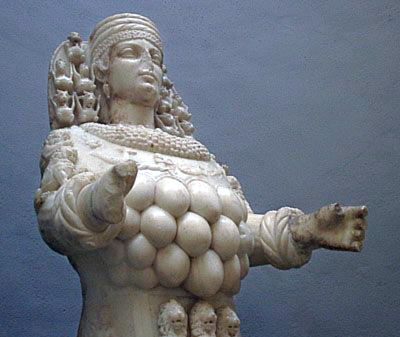
The drugged milk was in Burgess' book and aims to telegraph an infantile culture with a heaping tablespoon of allusion to mothers (perhaps even the motherland) whose milk is toxic rather than being the stuff of kindness.
What is ultimately most shocking is how attractive Alex is, despite the aura of violence about him. Kubrick's anti-hero is highly intelligent and insolently beautiful, standing out among his droogs for his self-possessed, unflinching gaze at the audience which he hails with his glass of milk, raising it in a toast, while all else in the bar rest in an apathetic, near catatonic state of repose, as quiescent as the mannequins.
He is partly as attractive as he is because of this liveliness.
The highly stylized figures used as furniture hint of S&M, address as art, and are inescapably confrontational.
The figures, done by Liz Moore, were based on art by Allen Jones who had denied Kubrick use of his own art in the film.

Had Kubrick convinced Jones to let him use his works, as duplicates would have had to be made it's to be wondered how closely the mannequins would have conformed to Jones' initial vision or if there would have been changes. Moore's figures keep an S&M quality but abandon the garments for the shock of exposed genitalia. People as furniture were already spoken of in Lolita and Peter Sellers himself materialized out of a chair covered with a white cloth. People as furniture appear also in Eyes Wide Shut with a man acting as a table at Somerton. One could say it is a kind of shape-shifting, which we also have referenced with the red Djinn furnishings in 2001, Djinn being shape-shifters and the red chairs were actually "Djinn" chairs by Olivier Mourgue. So, the mannequins are more than mere decoration, they are an idea used throughout Kubrick's films, appearing first in Killer's Kiss in the mannequin storehouse in which the boxer kills the owner of the dance club.
The drinkers in the bar are surrounded by representations of women, all highly sexualized. Some are furniture. The milk dispensers are bound, like slaves. Alan Jones has done a lot of work in which dominatrix women are depicted, and also a fair amount of work in which women aren't much more than fetish objects. He states the work was a natural outgrowth of popular illustration of the 1940s and 1950s, which is most apparent in his works on paper. He also gives his work as influenced by Jung and Nietzsche. As transgressive works, it could be argued that they are "freeing", bringing what is veiled and hidden into the open. But feminists had a problem with them, as do I, because of implied masochism and misogyny, in that one has the feeling these weren't works exposing and commenting on problems of inequality and masochism but were...well...marketing it. Women were still invisible in the arts as creators in the 70s, and hyper-sexualized women serving as BDSM furnishings seemed rather redundant when one was treated as an object no matter where one went and had to contend with all manner of harassment. Even where the feminine is depicted as dominant, it seems a male-ordained fantasy, the woman pressed into a male-idealized model, while being denied real power and agency in her life. Which isn't to say that I believe such works require repression, but give them some context.
I don't know why Jones denied Kubrick use of his works, but he may not have liked that Kubrick would be using them in a dystopian world in which women were raped and killed, because the works would be, by virtue of this, placed in context.
Let me put it to you this way. How comfortable would I feel, as a woman, if I was invited to someone's house and we had to conduct all our discussions around the figure of a woman serving as a table? I'd feel on guard, defensive, diminished, and would be inclined to smash it.
5 MS Bum with alcohol bottles (02:18)
With the mention of ultra-violence Kubrick cuts to a bum in trench coat, lying singing in a tunnel-like concrete area. Drunk, he has beside him two alcohol bottles, one empty and the other half full. The gray-black of the tunnel re-creates, to a certain extent, the cavernous milk bar, though one is social and posh and the other is a place of destitute isolation. Both venues are devoted to altering the senses.
The Irish bum doesn't appear in Burgess' book, and though his presence in the film went largely unquestioned by me initially, he seemed also a slightly misplaced puzzle piece until it occurred to me, as I've previously mentioned, that there might be an association being made by Kubrick between the paramilitary droogs and the Orangemen.
An assault is made on a bum in the book, but it is one of the later assaults, the individual isn't Irish and he is singing a different song. Kubrick made this individual Irish for a reason. He made him obviously, unquestionably Irish with the singing of Sweet Molly Malone.
I never fail to be surprised by the initial appearance of the bum. He has always looked to me like a busted puppet with legs brokenly bent. If he tried to rise, his legs seem as though they'd offer no support, much the same as the writer who is later confined to a wheelchair.
We will see to his side fragments of a meal littered about the bottles, including a couple of unidentifiable bright red scraps.
In Dublin's fair city
Where the girls are so pretty (he belches)
I first set my eyes on sweet Molly Malone
As she wheeled her wheelbarrow
Through streets broad and narrow...
The shadows of Alex and his gang spread fearfully long and tall over the bum as he sings, oblivious to the threat of the gang.
"Crying cockles and mussels alive, alive, oh."
ALEX (VO): One thing I could never stand is to see a filthy, dirty old drunky...
6 Extreme LS Opposing view of Alex, his droogs and the bum (02:55)
We now have an opposing shot of the tunnel and it is different from the first shot, the tunnel seeming much much deeper, its space now suggesting a triangle with its undefined apex lost in a distant wash of night lit by an overhead blue light. Alex and his droogs stand at the distant entrance to the tunnel, backed ominously by the cold-blooded blue light, the same light that we will see later in the film when the effectiveness of Alex's brainwashing is tested.
The elder bum with his Dionysian alcohol seems powerless in comparison to the young thugs whose violent tendencies have been sharpened and augmented by their favored, drugged milk. Maternal milk is often associated with compassion, but this has been subverted, overturned, as represented by the hyper-sexualized and chained mannequins that deliver the drugged milk at the bar, and one of the reasons for this scene seems to be to highlight the usurpation of alcohol by the drugged milk.
In voice over, Alex continues to speak of how he hates these drunkards...
ALEX (VO): ...howling away at the filthy songs of his fathers and going blurp blurp in between as it might be a filthy old orchestra in his stinking rotten guts. I could never stand to see anyone like that whatever his age might be, but more especially when he was real old like this one was.
The reference to the belching out of the filthy old orchestra has relevance to what happens later with Alex and his bouts of belch-inducing nausea that are a result of his reconditioning.
Entering with their clubs, imposing cod pieces strapped on their trousers, Alex and his droogs gather round the old man.
In this shot the whole form of the man can be seen as showing a face in profile--hat, brow, nose, mouth, chin. It rather presages the upcoming profile shot of Alex.
7 LS Alex, his droogs and bum (03:13)
They applaud as he finishes his song.
BUM: Can you spare some cutter, me brothers.
Alex stamps his cane in the bum's stomach threateningly.
8 MS Bum with cane in stomach (03:27)
BUM: Oh, go on. Do me in you bastard cowards. I don't want to live anyway, not in a stinking world like this!
Shot 7 | Shot 8 |
 | 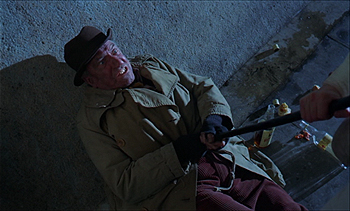 |
9 CU Alex (03:37)
Side shot of Alex menacingly asking what's so stinking about it? The blue light from behind gives a white electrical luminescence to the fine hairs that> cover his face.
ALEX: Oh? And what's so stinking about it?
The droogs laugh as the derelict answers there's no law and order any more.
10 MS Bum (03:42)
BUM: It's a stinking world because there's no law and order anymore. It's a stinking world because it lets the young get on to the old like you've done. Oh, it's no world for an old man any longer. What sort of a world is it at all? Men on the moon and men spinning around the earth and there's not no attention paid to earthly law and order no more.
Kubrick thus allows the bum to lodge his complaint against the world of 2001.
BUM (singing): Oh, dear land, I fought for thee...
11 Extreme side close-up Alex (04:19)
As the bum breaks into a song about having fought for his land "...and brought...", there's a sickening thud as Alex lays into him with the cane, the other droogs then joining in with the beating.
So, if the young have not inherited the violence, if there was previously law and order, then what is their inspiration? I read the song is supposed to continue, "and brought you peace and victory" which belies what we're seeing here. This isn't peace. This isn't victory. As the bum sings, the cut made to an an extreme close-up of Alex's face and his emotional reaction reveals a moment of personal rage on Alex's part before it is swallowed by the communal aspect of the group, they now joining in on the beating, whooping and yelling in joyous celebration.
Which marks a difference between Alex and his group. With Beethoven's "Ode to Joy" later being given as serving as inspiration for Alex, and the glorious exaltation he experiences during it being what is most remembered of Alex and his violence, we subsequently lose sight of the anger which is briefly shown in this scene, a rage against society (as represented by the old man) that we don't see in his droogs.
12 LS The droogs attack the bum (04:24)
Shot 10 | Shot 11 |
 |  |
Shot 12 | |
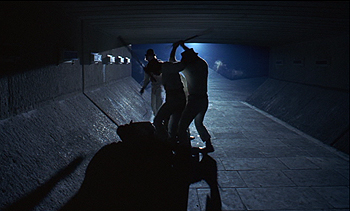 | |
The Royalist Burgess had to say about A Clockwork Orange:
I foresaw that the Queen's Peace was going to be greatly disrupted by the aimless energy of these new young, well-fed with money in their pockets. They were not, of course, all that new. The apprentices of Queen Elizabeth I's time used to riot, but they were dealt with in a very summary way - sometimes hanged on the spot.
And from another interview, regarding A Clockwork Orange,
I despise whatever is obviously ephemeral and yet is shown as possessing some kind of ultimate value. The Beatles, for instance. Most youth culture, especially music, is based on so little knowledge of tradition, and it often elevates ignorance into a virtue...And youth is so conformist, so little concerned with maverick values, so proud of being rather than making, so bloody sure that it and it alone knows.
As if youthful violence is all of its own inspiration and nothing but a threat against "the Queen's Peace" by the young who Burgess counted as too well fed, having too much money, too much time and no direction.
As if history hasn't been made through older, monied men relying on the energy of youth to aggressively uphold their interests and traditional values in battle, taking advantage of that vigor and selling it as essentially expendable.
Even with only a little familiarity with 2001 one flashes back to man at his most primal, infant state, after its brush with the monolith, coming into possession of the intellect which is used to gain supremacy with violence (the bones there, the canes here) and if that violence was cold war diplomacy in the space age scenes of 2001, in A Clockwork Orange the children of it are without apology. Ultimately, Georgie Boy and Dim will find a comfortable place in the system against which they seem to be rebelling, which is in the novel, so Burgess understood how close to the State were Georgie Boy and Dim, rather than in moral and ethical opposition to it. Yet his comprehension of his own characters and their motives becomes, in the end, hopelessly muddied, and he even betrays much of the story he's built in order to salvage his traditionalism.
Burgess' attitudes on youth and violence paradoxically allowed little room for looking to the generations before for inspiration either, apart from the inheritance of the hormonal hamster wheel.
To me the most notable thing about the location where the violence occurs is revealed by a Google map.
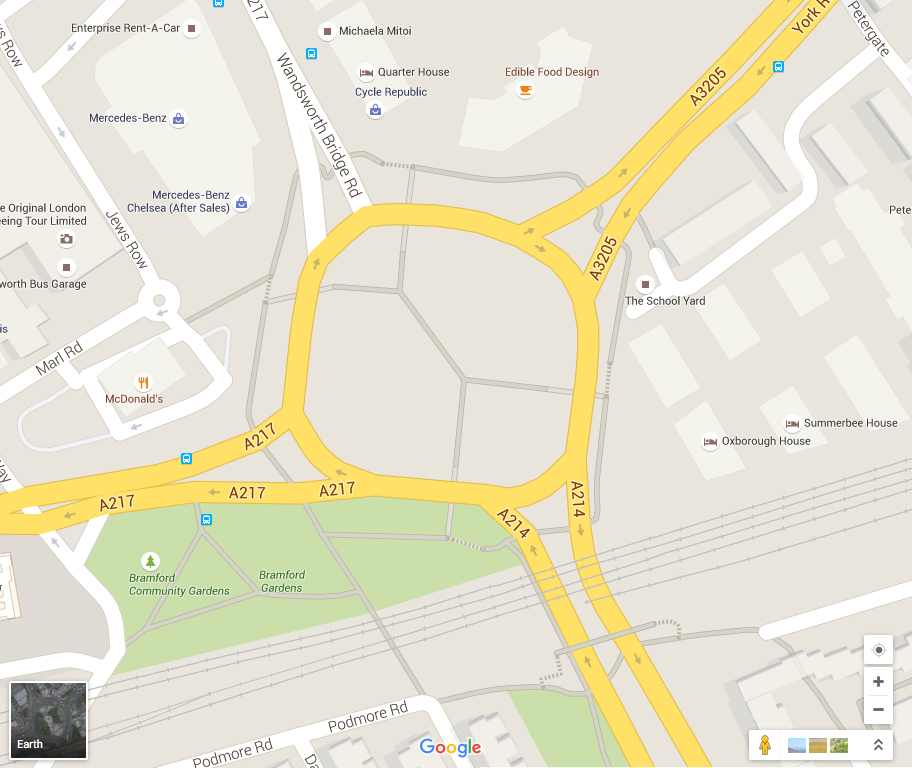
This should be compared with the overhead shot of the prison where Alex is incarcerated.
Also the circular dynamic in which the prisoners are bound in their exercise yard. Kubrick is ever concerned with the problem of the trap of circularity as represented by deja vu. This occurs again and again in his films and we have it in A Clockwork Orange. For instance, with Alex again later encountering the Irishman after the Ludovico treatment.
The casino in which the following scene takes place is also a Kubrick invention, not in the book. The fight is in the book but it takes place near some power station.
13 MS A painted vase of flowers (04:29)
Cut to viewing from below a 17th century style graceful painting of flowers spilling out of a vase atop a balustrade that is depicted with such skilled perspective it seems real rather than an artificial ornamentation of the ceiling. A woman's screams are heard through the strains of Rossini's "The Thieving Magpie". The camera pans down to show a gold toned sculpture below, the head of a bearded and crowned antique deity on an archway overlooking a theatrical stage--perhaps Poseidon, accompanied as he is by scalloped shells, though Dionysus is the patron god of theater. Against the back wall of the stage is a dirty old pink and white patterned mattress. We see several oversize costume heads, all cartoonish and grotesque, one of a black man in red Fez, and next to it a white man in a university style diploma cap (generations of education looking over the scene). Stark shadows again extend against the back wall. Men in camouflage jackets and assorted military hats are flinging about on the stage a woman who vainly struggles against them, her clothing in shreds. The camera pulls back further revealing the full stage with its torn theater curtains.
The principality of Orange--captured by Louis XIV and eventually ceded to France in 1713--was not originally connected with the fruit or the color orange, instead having been named after a Celtic water god, Arausio, and the color orange adopted as a symbol of the House of Orange-Nassau in the 16th century. Somehow Arausio was corrupted into Orange.
At Arausio there was built, about two millenia ago, what became a very famous theater throughout the Roman Empire, due its wonderful acoustical design, and survives to this day--a matter of interest because the film begins now to be full of stage/theatrical references. Count that just as a fun fact.
Alex will, with his song and dance routine, turn HOME into a dance stage. Another stage will be that on which the reformed Alex is abused by the man who forces him to lick his shoe, and then Alex both lusts after and is revulsed by the woman with bared breasts.
GANG MEMBER: Right! Get her clothes!
WOMAN: No!
ALEX (VO): It was around by the derelict casino that we came across Billyboy and his four droogs. They were getting ready to perform a little of the old in-out, in-out on a weepy young devotchka they had there.
In the book the young devotchka was no more than ten.
This film is full of stages, so we should pay attention to the idea of the devastated theater in which the audience seats are overturned and the curtains torn down, and we know the curtains are torn down rather than simply absent because Kubrick has left them there dangling from the stage. One could hazard a collapse of the partition that separates the audience from the theatrical, and perhaps a collapse of the partition between the theatre and what it portrays. The relationship between this staging area, the staging area of the writer's household, the Ludovico cinema, and the auditorium in which Alex experiences the effects of his cure with staged/real life situations need to be considered.
14 MS of the gang stripping the woman on the stage. (05:07)
15 LS The casino and stage. (05:20)
We view the whole of the theater and its audience area, a battered upright piano with JIMI on the side, red seating overturned, general debris, a roulette wheel table with the roulette wheel missing. The men have stripped the woman down to her Greek/Roman style sandals, the ties of one wrapped around her left leg (facing us) up to the knee.
As with the previous scene with the bum we have a prominent trapezoidal/pyramidal shape. The wine-colored shades of the drapery recall the color tone of the bum's trousers.
16 MS of the gang and woman on the stage again. (05:26)
We come back for another medium shot and this time the ties of the sandal remain wrapped around the woman's right leg (facing us) but not the left--indeed, when she lifts her foot we can see that she no longer wears a sandal on the right. A clown's head is viewed on a large radiator. The men throw the woman on two more pink and white patterned mattresses. Something like a gray kaiser head looks upon the scene in the background (it actually looks a little like Kubrick).
17 LS The dark rear of the theater. (05:47)
Cut to Alex and his droogs standing in the dark at the back of the theater.
Alex kicks a bottle as he advances.
ALEX: Ho ho ho! Well, if it isn't fat...
18 MS Gang on stage looking up. (05:58)
ALEX: ...stinking Billy Goat Billy Boy in poison.
The attention of Billy Boy and his droogs diverted, the woman takes the opportunity to flee--and, for a moment, ridiculously, Alex and his droogs become heroes, having saved her.
She wears again both sandals with the ties going up to the knee.
ALEX: How are thou...
19 CU Alex. (06:08)
ALEX: ...thou globby bottle of cheap stinking chip-oil.
20 MCU Billy Boy. (06:12)
ALEX: Come and get one in the yarbles, if you have any yarbles you eunuch jelly thou.
BILLY BOY (spits): Let's get 'em, boys!
21 MS Billy Boy and his droogs leap off the stage. (06:28)
Billy Boy and his gang are attired in 60s frilled Tuxedo shirts (one of them in orange) with camouflage jackets and leather trousers. Billy Boy wears a Nazi Iron Cross, as well as a Nazi hat with the Iron Eagle, and goggles. Around his waist is a cumber band sort of belt that is a skull head against perhaps a red sun. So, not only do Alex and his gang become quasi-heros through the woman being saved from rape by their intrusion, but because they are in opposition of a gang decked out in Nazi regalia. In their white uniforms they become the good gang.
Rather than a fight we get an all out slapstick ballet of a chair bashing, bottle breaking (1964 Moet and Chandon Brut Imperial Rose champagne) on head head-on brute brawl with Alex and Billy Boy and their gangs, all ferocious glee and fearfully even delightfully impressive after the horror of the anticipated rape scene. Perhaps a relief for the audience. We've not had to watch a rape. Instead we get a comic strip with Big Heads overseeing a wonderful, invigorating dance. The christening of Billy Boy with the Brut Imperial Rose seems a fitting touch.
Anyway, again, there's this disorienting conflict. We were prepared for a rape, reluctant to see it perhaps, and then instead we have this rather invigorating ballet of violence. Conflict. We're not supposed to like violence but this is fun, perfectly choreographed, and Alex and his droogs are being good guys in their saving of the young woman.
As for the Brut Imperial Rose and JIMI, keep these in mind when we get to the Chelsea drugstore scene and my discussion of Der Rosenkavalier.
22 LS Alex and his droogs. (06:28) Billy Boy and his gang rush upon Alex and his droogs.
23 LS Fight from the rear facing the stage. (06:32)
24 MS Alex fends off a bottle attack with a chair which breaks and flips another one of the gang over his head. (06:34)
25 LS Georgie-boy is knocked to the ground. (06:38)
26 CU Alex breaks a bottle against the right of Billy Boy's face. (06:40)
27 MS Alex runs and jumps feet first into table barricade one is holding... 06:41)
28 MS ...breaking it, then leaps upon him. (06:41)
29 LS Dim on the stage beats a gang member with a chain. Another comes up behind him and smashes a chair against his back. (06:45)
30 Billy Boy chases Georgie Boy and falls. (06:47)
31 Dim with two of the gang in headlocks. (06:49)
32 Alex leaps on a gang member and they fall over a table. (06:50)
33 Pete fends off an attack. (06:52)
34 A gang member leaps from the stage onto Georgie Boy (?) and Dim. (06:53)
35 Dim now on the stage throws a gang member off it. (06:56)
36 The gang member, thrown from the stage, falling onto a piece of furniture which shatters beneath him. (06:57)
37 Georgie Boy smashes a chair over a gang member's head, then ducks as another leaps over him and through a window. (06:57)
38 Alex cracks a window frame (?) over Billy Boy's head from behind. (07:00)
39 Dim cracks a window frame and glass over a gang member's head. (07:01)
Shot 22 | Shot 23 |
 |  |
Shot 24 | Shot 25 |
 |  |
Shot 26 | Shot 27 |
 | 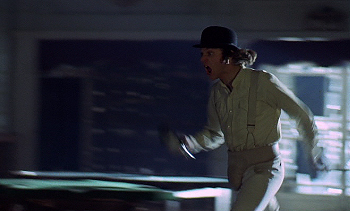 |
Shot 28 | Shot 29 |
 |  |
Shot 30 | Shot 31 |
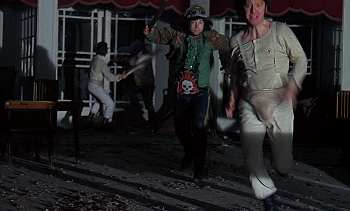 | 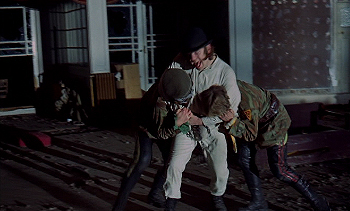 |
Shot 32 | Shot 33 |
 | 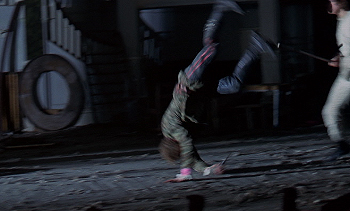 |
Shot 34 | Shot 35 |
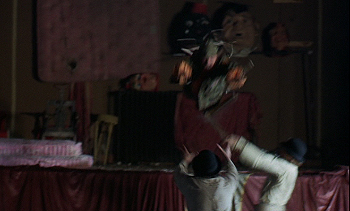 | 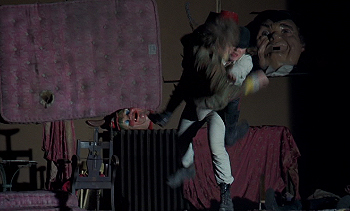 |
Shot 36 | Shot 37 |
 | 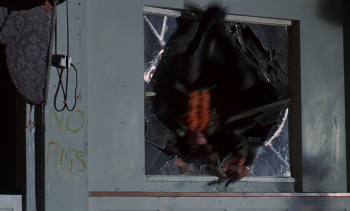 |
Shot 38 | Shot 39 |
 |  |
Shots 27 and 28 could very easily confused as being one shot but there is a break between Alex's leap and the slamming into the table.
40 LS Alex and the gang thrashing the subdued rival gang. (07:04)
Finally a long shot from one of the theater's corners shows Alex and his droogs, having beaten Billy's gang, finishing off the job with a good clubbing of their nearly immobile bodies.
The stage is now completely dark, no light falling on it. As the casino is derelict, abandoned, and would have no electricity, one wonders at the source of the bright white light in the background, for we are led to assume that all the happenings have occurred at night, and the light seems to be too brilliant for a street lamp. From where does the brilliancy emanate? This isn't to say that I think this has any particular meaning, but it is interesting the way Kubrick has treated the light in this scene. There was at first ample stage light and Alex and his droogs emerging out of the dark. Now we have a dark stage and this dramatic light through which Alex and his droogs will run and be briefly, starkly illuminated as they escape into the darkness of the door.
We have moved from red dominating the dark to it paling beside this combination of bright white electrifying blue drapery and the blue of the night beyond the shattered luminescent windows.
41 MS Alex beating a gang member. (07:11) Alex is thrashing a rival gang member with a club when he suddenly stops, alerted to something, and listens. He whistles for his men to be silent.
42 LS Alex and the gang from the rear of the casino. (07:17) Alex whistles again. All have stopped but Dim, who continues a beating. Alex whistles again. We hear the sounds of sirens.
ALEX: The police! Come on, let's go!
An authority more powerful than the gangs (the biggest gang of all, we shall later see) threatens, and Alex and his droogs flee, yipping, out the door.
Shot 41 | Shot 42 |
 |  |
"The Thieving Magpie" is an opera about a woman who is falsely accused of stealing a silver spoon, when instead a thieving magpie had done the deed.
Why, we might ask, the reference here to the thieving magpie, an intelligent bird that forms gangs and is known for its fondness for bright, shiny objects? Does it refer to Alex who will later be shown dropping into a drawer his thieved loot of some money but mostly shiny watches (clockworks)?
Looking at the flowers peacefully spilling from their baroque vases, I think of Rubens' "Rape of the Daughters of Leucippus", the nude women carried away with cherubim looking on, and Giordana's "Rape of the Sabine Women". Rape presented with artistic palatableness seemed often an excuse for showcasing passionate sensual nudes. And I wonder if Kubrick was here presenting a theatrical staging of this, a history of violence as condoned by the Big Heads on the stage, even the classical gods supervising this attempted rape of the woman in her classically thonged sandals.
Traditional values.
The hotel where the casino was filmed was on Tagg's Island and at the end of its life, after a long decline and a fire. It was used for discos and concerts before being purchased in 1968 by a Dr. Leon Joseph Bronesky, an American businessman, who had plans to put up a new hotel. This is interesting information considering the names of the Ludovico doctors are Branom and Brodsky.
Is this the same Leon J. Bronesky who developed Wonderama, also known as Miracle Arc 120? I bet it is.
In response to many requests from readers, International Projectionist has secured additional information on the Wonderama process described in an earlier issue. Intended for use in smaller theatres, Wonderama (formerly called Arc 120) is the invention of Leon W. Wells, and has been developed by Leon J. Bronesky.
Leon Bronesky, developer of the Wonderama process from an invention of L. W. Wells, is shown adjusting the adapter lens on standard projection equipment at the Strand Theatre, Plainfield, N. J.
"With the Small Theatre in Mind" ...
Wonderama Augments Capabilities
The incontrovertible fact that "Movies Are Getting Better All the Time" is further reinforced by a new process described briefly in a recent issue of International Projectionist, and known as Wonderama.
Contrary to the initial fears of some in an industry which is becoming "process-oriented," Wonderama is not a new entry to compete with Cinerama, Dimension 150, or any other wide-screen process. It has been designed specifically with the small theatre in mind, according to its developer, Leon J. Bronesky, and Walter Reade/Sterling, holder of Wonderama rights.
Walter Reade Jr., chairman of Walter Reade/Sterling, said at a recent demonstration at his company's Strand Theatre in Plainfield, N. J. that total conversion would cost approximately $3,000. The specialized lens is intended to be lent exhibitors by distributors handling Wonderama films.
Source: International Projectionist Jan 1963 to June 1965.
I read the process used, instead of 70 mm film, 35 mm film. The original wide screen image was split in two halves that were rotated 90 degrees and printed next each other. A public post on a Google board, by a Marty, stated that an optical voice was mounted on the projector which had two lenses and a set of prisms that rotated the halves and projected them back in their original relationship. "The purpose of two lenses was to allow each to
beam its image on half of an extremely curved screen and maintain good
focus. To hide the seam in the middle of the image an "impulse shutter"
was used. This little device was basically a square bar that rotated
at 10-15,000 r.p.m. and blurred the light at the join. "Of course only an
idiot would design a multiple image system with a join dead center, but
this one was supposed to be invisible."
The device's two lenses have been described as looking somewhat like binoculars.
Wonderama was used for the film Honeymoon in 1960 at the Palace Cinema in Blackpool, England, for the film Parisian Ballet at the Lutetia Cinema in Paris, and Mediterranean Holiday in 1964 at the Strand Theater in New Jersey.
Can you envision the Wonderama method and projector described earlier? I'm having a somewhat difficult time but I get the idea of the dual lenses and the center split that was hidden. And when I look at the attire in which Kubrick has dressed Billy Boy in goggles and holding a knife, I am reminded of Wonderama, the film split down the middle etc. and then projected through dual lenses that look like binoculars.
Did Kubrick know of Bronesky? It seems reasonable to me that he might have, as a director, been aware of Bronesky and his Wonderama (Miracle Arc 120). The significance I see in it I won't get into too much here except to say that I can see how Kubrick might have found in this an expresion for his use of horizontal flips and his dualities that meet at an invisible center or "between" symbolized by the monolith, such as I describe in Examining Kubrick's Single Horizontal Flip of a Front Screen Projection Landscape in the Dawn of Man Section in "2001" and the Meaning of that Flip in Relation to the Final View of the Monolith in the Film.
Bronesky's plans had been to build a new hotel at Taggs Island. He didn't. But had he done so, did he have plans to incorporate into that hotel a Wonderama theater?
The presence of the Fez takes me back to a scene in Killer's Kiss in which, while Davey is distracted by two drunken, dancing Shriners in Fezes, his boxing manager is killed by two thugs, mistaken for him. A large ad that we see behind the boxing manager, before he is murdered, is for Himberama, which was a stage show presented by a musician named Himber that promised a 4D experience. I write of this in great detail in the post Kubrick's References in Killer's Kiss to an Obscure Magic Film by Orson Welles so I won't go too deeply into it here, but Kubrick is referring back to that section and Himber, Himberama, and the film that Orson Welles made for Himber. For starters, in that film Orson Welles made for Himber, the magic, which began on the film and on the stage, was then expanded into the theater so that the audience was interacting with the stage and Orson Welles on the movie screen. I've written extensively on this dropping of the 4th wall in the above-mentioned post, its meaning in that film, and we need to take it into consideration with Billy Boy and his droogs leaping off the theatrical stage into the audience to battle Alex and his droogs. I will excerpt from my post on Himberama and Orson Welles one paragraph below.
In his films, Kubrick plays a lot with expanding the role of the actor/character so they become as real entities conjured by their god of a writer and are trapped in their predetermined world by that writer (or director). Wanting to keep this concise, I don’t have room to go into examples of how that’s so here so I’ll leave it at that. Kubrick also plays with the roles of the audience, action and camera, most pointedly in A Clockwork Orange, breaking down the fourth wall so the audience is intersecting directly with the action. For instance, when Alex is finally strapped into his chair in the theater during his programming, he is actor and audience staring at the screen, the movie he’s watching replicating his thug/droog life, a scene during which we have his famous remark that blood always looks more real on screen. Later, he does in fact watch real life movies of Nazis. As Alex watches from his position in the audience, he looks at us, the audience, and we are not only the audience watching him in turn, we’ve also become the screen upon which the movie is being played, those flickering images of both the imitative film and the real life actions of the Nazis. The confluences of reality, celluloid and theater are explored, the stage presented again and again in A Clockwork Orange, activity taking place both on and off it, such as when Alex and his droogs interrupt the rape of the woman on the casino stage and the opposing gang leaps off the stage and engages in a fight with what is in effect their audience. Then when Alex assaults the writer and rapes his wife at HOME, this occurs on a stage, the lighting design being as stage foot lights and the cinematic audience hidden in the dark window beyond them, a window which we face and so we are also removed from the audience and become as participants in the action. One could write pages upon pages on Kubrick’s work with content and its relationship to audience and the creator of the content, this being a strong component in all his films, but I’m trying to be concise here. I’ve examined this more thoroughly in my analyses for I’ve paid attention to Kubrick’s doing this for some time.
43 LS Alex and his gang in the Durango (07:33)
Now an obvious (and wonderful) rear screen projection shot of Alex and his droogs in their "Durango 95" (an M-505 Adams Brothers Probe 16, "an investigation into the extremes of styling") roaring down a surreally illumined wooded country road, the car's top down, they howling in adrenalin delight, Alex at the wheel.
DAV 485Q is the license number.
ALEX: The Durango 95 purred away real horrorshow. A nice warm vibratey feeling all through your guttiwuts. Soon it was trees and dark, my brothers, with real country dark.
44 LS A Mack truck parked across the road. (08:04) The driver stands in the middle shining a flashlight warning of the truck blocking the road, two emergency lamps shining also to either side of the road, giving a triangle formation of light.
They speed under the mack truck at the crossroads, careless of their own safety, sending the driver fleeing. Several times in the film Kubrick makes use of a bright light near to center screen shining directly into the camera. We've much the same here though we are watching from the side of the Durango.
45 CU Pete (08:13)
The word Durango comes from Urango, Water Town. Just making note of that as I always forget.
46 LS Lights of an approaching VW. (08:17)
They send a white or very light blue VW flying off the right side of the road.
47 CU Georgie Boy yelling with the thrill of it. (08:21)
Cut back to another close shot of another droog, Georgie Boy, with Rembrandt style lighting and flesh tones.
48 LS of a single light approaching. A similar light above, stationary. (08:25)
Cut to the Durango sending a motorcyclist in a white bodysuit off the road to the right.
49 CU Dim yelling. (08:27)
50 LS Another pair of car lights approaching. (08:33)
A light blue van is run off the road into a shed of some sort.
51 MS Alex at the wheel. (08:38)
Now a close-up of Alex as he drives at the red wheel and a voice over on their playing hogs of the road with other travelers of the night...
Shot 46 | Shot 47 |
 |  |
Shot 48 | Shot 49 |
 |  |
Shot 50 | Shot 51 |
 | 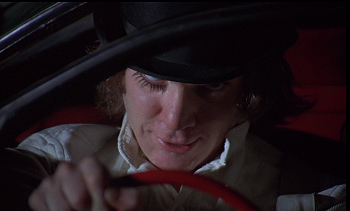 |
ALEX (VO): We fillied around for a while with other travelers of the night, playing hogs of the road. Then we headed west. What we were after now was the old surprise visit. That was a real kick and good for laughs and lashing of the old Ultra-Violent.
The road is narrow so it's difficult to tell what lane the Durango occupies, but it seems to be in the right lane when in England one instead would drive in the left lane. Perhaps for camera effect, each vehicle run off the road has veered to the right and sometimes seemingly even more directly in front of the Durango in order to go off the road to the right.
Why would Burgess call the car a Durango? If we consider the connection of "Durango" with film, there is Durango, Mexico, also known as "the land of cinema", where a number of westerns were made, (including Viva Zapata, which had in its cast Frank Desilva who was in Kubrick's Fear and Desire as well as Killer's Kiss). In the paragraph in which the decision is made to steal the Durango, Burgess describes a cinema showing westerns, "the usual cowboy riot, with the archangels on the side of the US marshal six-shooting at the rustlers out of hell's fighting legions", and then he gives the Durango as eating up the road "like spaghetti", which would be a reference to spaghetti westerns. So it seems that Burgess named the car a Durango because of western film. I can see why Kubrick would have wanted to keep in this tie to the Land of Cinema.
The joke is that they go so far west that they end up at a home with a Japanese garden, at least in Kubrick's film. West giving way to the East. One might be reminded of Lolita and how she ran off with Quilty in the west, going to live at his ranch in New Mexico where they made "art" films. Quilty, who also abused her, was favored by Lolita as he had an oriental Japanese philosophy on life.
From Nabakov:
Well, the idea was he would take her in September to Hollywood and arrange a tryout for her, a bit part in the tennis-march scene of a movie picture based on a play of his--Bolden Guts--and perhaps even have her double one of its sensational starlets on the Klieg-struck tennis court. Alas, it never came to that.
"Where is the hog now?"
He was not a hog. He was a great guy in many respects. But it was all drink and drugs. And, of course, he was a complete freak in sex matters, and his friends were his slaves. I just could not imagine (I, Humbert, could not imagine!) what they all did at Duk Duk Ranch...
But Quilty is a person of the east. Kubrick has Lolita describe Quilty in this way:
He wasn't like you and me. He wasn't a normal person. He was a genius. He had a kind of uh beautiful Japanese oriental philosophy of life.
52 LS HOME sign and lit gate. (08:59)
Shot of a quiet drive with two short security pillars blocking, beside them a low brightly lit sign reading HOME. The Durango approaches from the opposite side, stopping at the pillars. The droogs climb out of the car.
In the car's headlamps, the country earth drive appears to be wet though we've had no other signs of rain.
53 LS Mid 20th century high modern architecture residence. (09:26)
Cut to the gang creeping up on a stately house of angular modern architecture.
Home! Oh my, how inviting!
Home is a very nice place, indeed. Surrounded by water, it seems to go very well with the Durango's water town etymology. Actually, the water anticipates Alex's next visit, after the Ludovico treatment, when he accidentally stumbles upon HOME in the pouring rain.
Burgess does not include the zen/Japanese garden. This is Kubrick. The house was designed by a Paul Litchfield and the garden was designed by a Japanese man and a son of the owners of the house, the raked pebble part modeled after the Ryoan-ji zen temple garden (Temple of the Dragon at Peace).
The peace of the household is about to be broken, but we also find that the writer and his wife are not as peaceful as they seem, that Alexander, the writer, has, in essence, given birth to Alex and has a deep metaphysical connection with him.
One way of looking at it is in the tao symbol there is that dot of black in the field of white, and in the field of black is the white dot. Alex rather erupts out of that black dot.
The music recedes.
54 MS The writer, Alexander, at his typewriter. (09:38)
Cut to a shot of writer, Alexander, a balding man in the pristine white sanctity of HOME, typing away at his red IBM typewriter (we shall see later that Alex has also a red typewriter), a blue box to his right (our left) filled with typewritten copy, paper at his left, a stapler, scissors, and other desk top paraphernalia. Bookcases filled with hardbacks stand at his rear. He wears a bathrobe with red and white spiral decoration. The doorbell ringing, Alexander looks to the side and wonders, "Who on earth that can be?"
The camera pans right so we get a view of the ultra 60s modern interior of two long parallel rooms composed of several tiers. The right room is sparely furnished, functioning more as a museum for its few pieces. On the first, lowest tier is seating composed of a white pod with purple interior. Red and black seating of a quasi heart shape is on a higher tier under a gray heart shaped painting/sculpture on the wall to the right. The white bubble pod with its open door forms also a quasi heart in which sits, reading, the author's younger red-haired wife, attired all in bright red.
HOME obviously is where the heart is.
The white pod that holds the woman should remind of the pods in 2001.
Even the sliding door to the left of screen, fitting as it does against the wall, becomes less a door and more of an art object, resembling a white canvas.
Some of this interior architecture, such as the sliding door and the tiered levels, may not seem new now, nor the long and deep room, but they were very new then, believe me. This was the home of a person several cuts above.
A little later, we will see a bright orange spheroid object on one of the writer's shelves, the utility of which is elusive and may be purely decorative. Because it's orange, it stands out. And what it brought to mind, for me, was the rhyme of Peter Peter pumpkin eater, who had a wife and couldn't keep her, he put her in a pumpkin shell and there he kept her very well. Which was the feeling I first had of the scene when watching it many years ago, of an older man with his younger, subservient wife in her pumpkin shell.
ALEXANDER's WIFE: I'll go see.
Never granted a name or identity apart from being "Alexander's wife", the woman climbs out of her bubble saying she'll go and see who's there. Ascending the stairs, she passes through a door to the rear.
55 LS Alexander's wife enters a mirrored foyer. (10:08)
She enters a long foyer, its walls left and right being entirely mirrors set in natural wood so we see her reflected on either side. The ceiling is exposed natural beams running left to right, and the floor is black and white tile. At the end of the hall we see a globe light on a pedestal, matching the others in the front room.
I earlier noted, "One way of looking at it is in the tao symbol there is that dot of black in the field of white, and in the field of black is the white dot. Alex rather erupts out of that black dot." Our first view of the house was of two neighboring areas that were all white walls, bright shining walls of white, which are the antithesis to the black walls of the milk bar that opened the film. Now, in the foyer, where the outer world meets the inside world, we have the black and white chess/checkerboard tiles. The mixing of black and white.
We have already seen how the white chair out of which the woman had risen could call to mind the white pods in 2001. It's likely that the entry foyer's floor should recall the chess board in 2001 and the problem of Frank's losing the chess game and HAL's error in describing that loss, the computer revealing itself as adopting the perspective also of the opponent without seeming realization of this crossing/inversion of boundaries.
It's important to note that though the other part of the house's interior was a real place, this entrance foyer, with its chess/checkerboard black and white alternating tiles and infinity mirrors, was a set. (In fact, three locations and a set went into the artifice of this house. The road to HOME was in a different area. The exterior of the house was another place. And this entry was built.)
She answers the door, opening it as wide as the chain will allow. Alex, bathed in blue, answers in normal, conversational English, revealing he has two modes of speech.
ALEXANDER's WIFE (at the door): Yes, who is it?
ALEX: Excuse me, Mrs. can you please help, there's been a terrible accident.
ALEX: My friend's in the middle of the road, bleeding to death, can I please use your telephone for an ambulance?
ALEXANDER's WIFE: I'm sorry, but we don't have a telephone. You'll have to go somewhere else.
She lies. Rather than just saying "no" she lies in order to not be thought of as denying. One could take this as an error on her part. She attempts to press the door shut but Alex braces himself against it.
ALEX: But, Mrs...
56 MS The writer, Alexander, at his typewriter, viewed from his left. (10:29)
Cut to Alexander listening. Afforded another view of his room we see more bookshelves, another of the globe lamps on a pedestal, an orange spheroid object, and a phone. Of course they would have a phone. What a bad liar, she is.
ALEX: ...it's a matter of life and death!
ALEXANDER: Who is it dear?
ALEXANDER'S WIFE: There's a young man here. He says there's been an accident. He wants to use the telephone!
ALEXANDER (after a moment's reflection): Well, I suppose you better let him in.
ALEXANDER's WIFE: Well, wait a minute, will you?
Alexander's wife's first impulse was to turn Alex away. Rather than telling them to get lost she lies and says they haven't a phone. When her husband tells her to let Alex in, rather than sticking with her better instincts, she does as her husband says, going by his judgment.
57 LS Alexander's wife at the door. (10:43)
Return to the wife opening the door, apologizing for not usually letting in strangers in the middle of the night, Alex backing through the door, and as he turns we see he now wears a grotesque phallic costume nose mask, his droogs pouring in after him.
ALEXANDER'S WIFE: Excuse me, but we don't usually let strangers in in the middle of the...AHH!
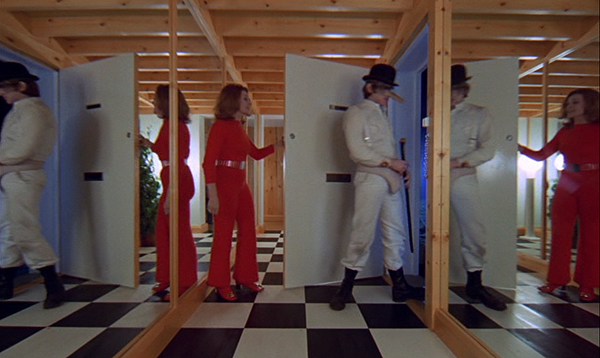
Trapped in the narrow entry corridor, the woman has no opportunity to run. Trapped as she is in the entry, the dual mirrors infinitely play, left and right, the beginning assault upon her and her home.
Seizing her, the droogs drag the woman down the hall back into the main body of the house.
Despite the assault on the old Irish bum, because of Alex and his droogs saving the young woman from being raped, the audience could hold ambiguous emotions concerning them up to this point, in part due to McDowell's charisma. The old Irish bum was, after all, old. And a drunk Irishman. Who cares about an old, drunk Irishman? As far as many in the audience are concerned, an old, drunk, homeless Irishman kind of deserves what he gets--and if he doesn't exactly deserve it then at least he wasn't someone useful to society. But now the droogs have invaded the sanctity and repose of home and things become increasingly uncomfortable, especially due the intimacy of the word HOME.
58 LS Alex and the droogs dragging Alexander's wife back into the main room. (10:50)
As the droogs drag the woman into the house, we now more closely observe a peculiar piece of art that resembles some kind of suit of modern armor, which is strange for a "home" so focused otherwise on heart. The suit also brings to mind a kind of environmental suit, such as an astronaut's. The suit hasn't the sterile aesthetic of 2001) (though this home has, and in the pod in which the woman read we might glimpse the pods from 2001), belonging instead to a world more in line with Mad Max). (For more on this see the Chelsea drug store section in which I discuss the suit again.) Alex pulling the woman through the door next it, we have a vague sense of the suit being of a size suitable for a giant. It is huge.
We realize the large bulbs lighting the room resemble the lighting in the milk bar on a larger scale.
They thunder down the stairs. The writer having risen from his desk and approaching, Alex kicks him under the chin, which sends him reeling in a somersault. Georgie Boy leaps on him.
59 LS Low. Georgie Boy leaping on the writer. (10:56)
60 MS Dim twirls the writer's wife. (10:57)
61 MCU Alexander. (10:57)
Alexander struggles on the floor, bleeding from the mouth. The line of blood curving down his face to the ground recalls the bright red semi-spiral tendril design on the white of his robe. The blood that has splattered the robe blends in with the design.
Shot 59 | Shot 60 |
 | 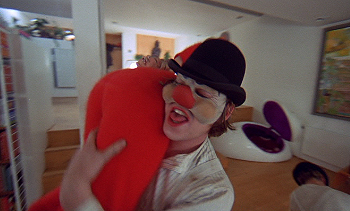 |
Shot 61 | |
 | |
62 LS facing the room's windows. (11:01)
Dim in his red clown nose holds the struggling wife over his shoulder and Pete leaps about on a legless purple lounger as Alex whistles for attention, ever leading and providing focus for his droogs.
ALEX: Pete, check the rest of the house. Dim...
Pete running to check out the doors in the writer's room, Alex takes out a ball and bounces it on the floor, doing a quick soft shoe shuffle--and now begins the infamous "Singing in the Rain" scene, Alex kicking the writer as he sings, striking the writer's wife with his cane.
The lights in the background give the impression of stage lights, heightening the performance aspect.
ALEX: I'm singing in the rain, I'm singing in the rain. What a glorious feeling, I'm happy again.
He thrusts the ball in the woman's mouth and tapes it in.
63 MS Alex taping the woman's face. (11:28)
ALEX: I'm laughing at clouds, so dark up above, the sun's in my heart and I'm ready for love.
He slaps the woman on the face.
64 LS Return to shot as 61, facing the windows. (11:36)
Her buckled shoes, however stylish for the time, have always, especially in the shots in which her pants are pulled up to her knees, reminded me of the fanciful buckled shoes of baroque times.
ALEX: Let the stormy clouds chase (he kicks the writer in the stomach), everyone from the place (he kicks him twice then kneels), Come on with the rain...
Shot 64 | Shot 65 |
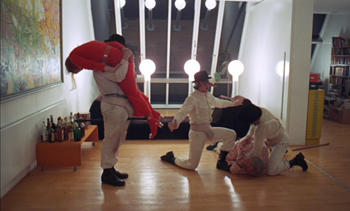 | 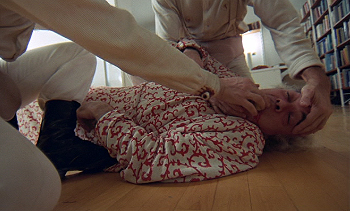 |
65 MS Alexander. (11:47)
ALEX: ...I've a smile on my face.
He slaps a yellow ball in the man's bleeding mouth, Georgie Boy droog taping it in.
A yellow ball in The Shining is what attracted Danny's attention to the open Room 237 door, having rolled down the hall toward him, preceding and even seemingly inviting him to a terrifying encounter.
66 LS The writer's desk from the front. (11:50) Alex has jumped up on the writer's table to dance upon it, turning its surface also into a stage, the desk lit by other stage lamps. He kicks off its contents...
ALEX: I'll walk down the lane, with a happy refrain.
He leaps off the desk.
ALEX: And I'm singing...
He flips the desk over.
ALEX: ...singing...
He knocks over the bookshelves behind the desk.
ALEX: ...in the rain.
NOTE: Thanks to David for the info that "when Alex is trashing Mr. Alexander's desk and then turns it over, to the left there is a book sticking out a couple inches more than the rest and that book is 'The Man From Keystone' by Bert Garai.
Kubrickian devotees of minor changes in details will note that the top of the desk is significantly more cluttered in the shots where Alex dances upon it. When first viewed in a panning left to right shot, as the droogs banged upon the door, the desk was directly before the large light in one of the shelves, but now it has been pushed further out. Also changed is the shelf upon which the large orange globe rests. Several books to the left have been replaced with another orange object in a shellac like the larger sphere, this new object recalling not just the larger sphere but also the pod chairs, having a shape much like them and a seeming pod hole opening revealing a black interior. But I have no way of telling what this object is so haven't given it any mind.
Curiously, behind the bookshelves, there is a hidden double cabinet with blackboards on its panels at floor level which, as these blackboards are behind the bookcase, would serve no use. These would have gone unnoticed had not Alex knocked over the shelves, and I would hazard that is one of the reasons for the shelves being overturned, to reveal these boards which go unnoticed by the audience that is instead concerned with the act of destruction and the impending rape. We are unable to view clearly what is written on the blackboards, only able to make out an arrangements of squares on the left and a circular image on the right.
We will again see blackboards at the prison.
67 LS from the floor of the right wall of the main room. (12:03)
Cut back to Dim holding Alexander's wife over his shoulder and Alexander pinned to the ground by Georgie Boy. A large painting of a garden is in the background.
Kubrick had seduced the viewer into vicariously, through Alex, experiencing the beautiful thrill of the earlier fight-ballet, we able to participate as we could side with Alex and his droogs seeming to rescue the woman on the derelict casino's stage from rape, and because of that, too, we could thus participate some in the thrill of Alex's dangerous joyride through the dark country streets. But that sympathy for Alex ends now, at least for a time, with his having violated HOME--not just anyone other's address, but HOME, the home of the viewer--and brutalizing the couple he finds there. But then we knew Alex was bad news from the first moment on. There was no doubt about it.
Alex, continuing to hum the song, stands before Alexander's wife.
68 CU Alexander. (12:03)
Cut to Alexander on the ground, red-faced, struggling, the yellow ball taped in his mouth. We see beyond the blackboard.
69 MS Alexander and Georgie Boy in foreground, Dim, Alexander's wife and Alex in the background. (12:10)
Alex had grabbed a pair of scissors off Alexander's desk. Now, Dim holding the arms of the woman, Alex begins singing again...
ALEX: I'm singing in the rain...
He cuts away one breast of her jumpsuit with the scissors, Dim echoing his words.
ALEX: Just singing in the rain...
He cuts away the other breast of the jumpsuit.
ALEX (removing her belt): What a glorious feeling...(he drops to his knees and takes hold of the hem of the woman's left pant leg)...I'm happy again. I'm laughing...
70 CU Alexander (12:28) A reaction shot of Alexander.
ALEX: ...at clouds...
71 MCU the woman. (12:30)
Cut to the woman from the front, her breasts exposed. We only see her writhing as Alex and Dim are kneeling at her feet.
ALEX: ...so dark up above, the sun's in my heart...
72 MS Alexander and Georgie Boy in foreground, Dim, Alexander's wife and Alex in the background. (12:38) Alex has cut the woman's jumpsuit from her hem up to her breasts.
ALEX: ...and I'm ready for love.
He looks pointedly over at Alexander.
ALEX: Let the stormy cloud chase...
73 CU Alexander (12:45)
74 MS Alexander and Georgie Boy in foreground, Dim, Alexander's wife and Alex in the background. (12:48)
ALEX: ...everyone from the place...
The woman's jumpsuit cut in half down the front, Alex and Dim strip the woman of it, removing her shoes as they pull it off over her feet.
ALEX: Come on with the rain, I've a smile on my face.
DIM: Ready for love!
Alex removes his codpiece and drops his suspenders.
ALEX: I'll walk down the lane, with a happy refrain...
Having dropped his trousers, Alex again looks over at Alexander, then drops to his knees before Alexander, thrusting his masked face before him.
75 CU Alexander (13:05)
ALEX: And I'm singing, just singing in the...
76 MS Alex in foreground, Dim, Alexander's wife and Dim in the background. (12:48) Alexander's POV now.
ALEX: ...rain. (Alex stops singing.) Viddy well, little brother, viddy well.
77 CU Alexander (13:14)
Alex having returned to Alexander's wife, cut to Alexander looking helplessly on. The extreme close-up on him with the wide angle may take us back to the big heads on the stage at the casino quiescently observing the near rape of the girl and the ensuing fight.
78 MS Alexander's wife. (13:19)
Shot from the bust up, Alexander's wife writhes as she is raped, Dim laughing.
Shot 67 | Shot 68 |
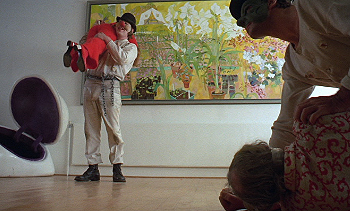 | 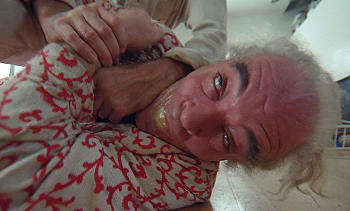 |
Shot 69 | Shot 70 |
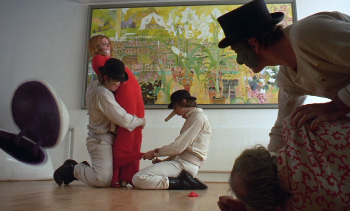 |  |
Shot 71 | Shot 72 |
 | 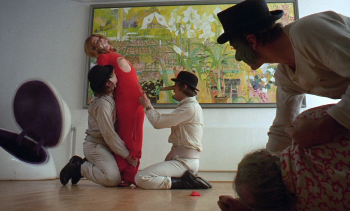 |
Shot 73 | Shot 74 |
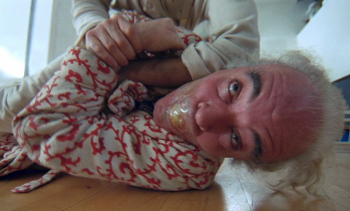 | 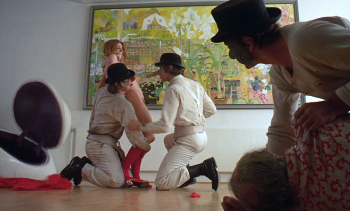 |
Shot 75 | Shot 76 |
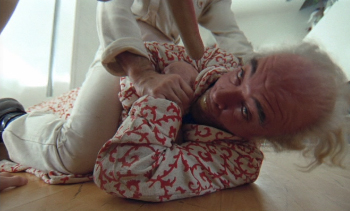 | 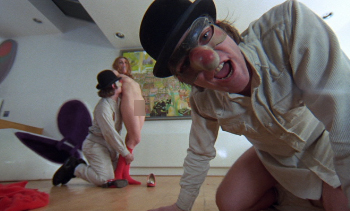 |
Shot 77 | Shot 78 |
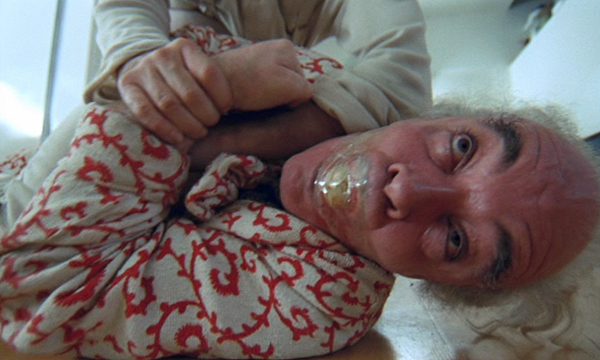 |  |
The movie Singin' In the Rain concerned the transition from silent films to talkies, with the audience believing that a prima donna actress had done all her own vocals, but at the end a curtain is pulled aside and it's revealed that her voice had been supplied by yet another, a chorus girl. I've read that Malcolm McDowell is the one who came up with the idea for using the song "Singing in the Rain", improvising, which is interesting considering how it became a key factor in the film. The secret singer behind the voiceless actress works well with the revealing of the concealed blackboards behind the books and the dual forms of Alex--the thug and the writer as Burgess who has created the thug and who serves as his voice.
So, "Viddy well little brother, viddy well," he intimately tells the writer, then proceeds to rape his wife off screen.
Viddy well, little brother. Alex and the writer are curiously associated.
In the book, the leftist writer was working on A Clockwork Orange, a fact never revealed in the film. I can't help but think Kubrick was, in part, taking a swipe at Burgess. For one thing, though Alex was identified as Alex DeLarge in the book, and is at one point in the movie, in one of the later news reports on him he is given as Alex Burgess. This all takes, yes, its cue from the book which has the left wing writer identified as Alexander, and Burgess may have been alluding in part to the character of Alex as being his own authorial creation, but I imagine instead Burgess was assailing the left wing due his personal belief in their coddling individuals like Alex, presenting youth such as Alex as the progeny of left wing policy. My opinion is Kubrick may have viewed Burgess as a part of the problem upon which he was commenting, that Burgess' traditionalism was to a fair degree composed of generations upon generations of foulness glossed over and glorified.
79 LS Entry to the milk bar. (13:22)
Cut to an opposing shot of the milk bar from what we'd originally viewed, now allowing us to see its entrance. Posters cover its black walls, one of those posters a yellow background with green phallic like nose extending long from between a pair of eyes, recalling Alex's phallic mask. It also recalls the image accompanying the graffiti "Kilroy was here" which was so popular during the mid and latter part of the 20th century. Wikipedia has some postulation that Kilroy may have grown partly out of "Foo was here", foo being a nonsense word used in WWII to refer to balls of light (UFO's) that baffled airmen in their seeming organized and peculiar flight. Kilroy--omnipresent like some ridiculous phallic nosed god--will make another appearance at Alex's home.
There is, notably, a poster/painting of a black woman in a large afro which is much like two paintings that will be seen in Dick's room in The Shining. This poster/painting hangs above a desk where sits one of the employees of the Korova bar reading, I believe, a comic book.
Despite the opening scene, in which we viewed others dressed as Alex and his droogs, I think the tendency is to strongly associate the look with Alex and his little gang alone, so when we see in the background, through a doorway, in this shot, another individual attired exactly like them, he seems like the 5th unknown gang member, perhaps because he is standing rather than seated, and perhaps because his back is to us. He will remain faceless.
Alex and his droogs wearily come down the stairs, and we've a voice over as Alex talks in his slang about how tired they were by their night of fun and so had ditched the (stolen) car and headed over for a nightcap.
ALEX (VO): We were all feeling a big shagged and fagged and fashed, it having been an evening of some small energy expenditure, oh me brothers...
Alex and his droogs have now passed the camera which turns to follow their progress into the bar.
ALEX: So, we got rid of the auto and stopped off at the Korova for a nightcap.
80 LS The gang in the bar, serving themselves. (13:47) Cut to an opposing view again so we see the exit beyond. Alex stops at one of the mannequin vendors on the left to get a drink.
Dim, who had just participated in the violent rape of a woman, personably and gently addresses one of the mannequin milk maids as Lucy, asking if she's had a busy night and pardoning himself as he tweeks a red phallic object positioned between her kneeling legs and vends the beverage from her breast.
DIM: Hello Lucy? Had a busy night? We've been working hard, too. Pardon me, Luce.
81 LS A group of 4 men in tuxedos and a woman in evening dress. (14:12)
Forming their own "gang", as one enters there is a group of four men similarly attired to each other in tuxes. One of the men wears a bright red bow tie and another a blue one. In the midst of the men, between a gentleman in a black tux and one in white, sits a woman holding musical manuscript.
Alex and his droogs seat themselves on the right, the area they'd earlier been seated in now occupied by two of the bar's bouncers whose poses give entrance to a possible homo-erotic aspect of the brotherhood of gang culture.
The woman with the manuscript begins to sing.
ALEX (VO): There were some sophistos from the TV studios around the corner, laughing and govoreeting. The devotchka was smecking away, and not caring about the wicked world one bit. Then the disc on the stereo twanged off and out, and in the short silence before the next one came on, she suddenly came with a burst of singing...
SINGER: Freude, schöner Götterfunken,, Tochter aus Elysium...
82 CU Alex. (14:41) Cut to Alex.
ALEX: ...and it was like for a moment, O my brothers, some great bird had flown into the milkbar and I felt all the malenky little hairs on my plott standing endwise, and the shivers crawling up like slow malenky lizards and then down again.
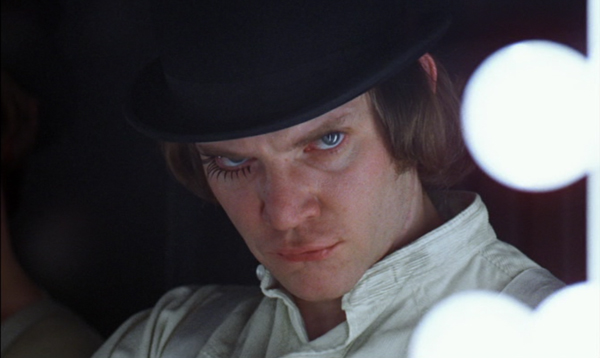
83 MS singer surrounded by the tuxedoed men. (14:57)
SINGER: Alle Menschen werden Brüder...
ALEX: Because I knew what she sang. It was a bit from the glorious 9th, by Ludwig van.
The woman, her eyes embraced with gold wings of shiny make-up, finishes singing.
84 MS Alex and his Droogs. (15:05)
Dim blows a raspberry in contemptuous disrespect. Alex, experiencing his own joy over this music, rather than feeling a radiant brotherhood as expressed in the song, slaps Dim's thigh hard with his cane provoking a surprised scream from him. Dim brushes Alex's cane away, leaning over in anguish, and Alex, never breaking his gaze from the songbird, nods and lifts his drink to her in a toast.
85 CU The Singer. (15:11)
The singer stares back with a seemingly befuddled expression, but there is very little to judge its meaning precisely, her mouth frozen in an open half-smile, her gaze almost blankly unwavering as she returns Alex's gaze.
Shot 84 | Shot 85 |
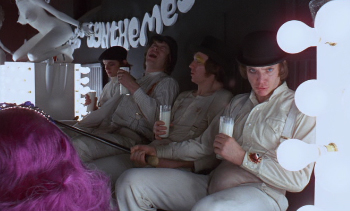 | 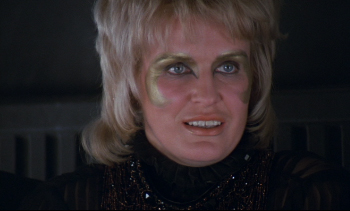 |
86 MS Alex and his Droogs. (15:12)
DIM: What did you do that for?
ALEX (his gaze still on the woman, speaking out of the corner of his mouth): For being a bastard with no manners, and not a dook of an idea how to comport yourself publicwise, oh, my brother.
Again, Alex raises his glass to the woman, smiling.
DIM: I don't like you should do what you done. And I'm not your brother no more, and wouldn't wanna be.
This last attracts Alex to look at him.
ALEX: Watch that. Do watch that, Oh, Dim, if to continue to be on live thou dost wish.
DIM: Yarbles. Great bolshy yarblockos to you.
87 MS singer surrounded by the tuxedoed men. (15:49) The woman and the men in tuxedos gaze upon the altercation.
DIM: I'll meet you with chain, or nozh, or britva, any time. Not having you aiming tolchocks at me reasonless.
88 MS Two of the seated bouncers, relaxing, also looking on the scene with interest. (15:56)
DIM: It stands to reason. I won't have it!
89 MS Alex and his Droogs. (15:59)
ALEX: And I'll scrap any time you say.
Georgie Boy, seated betwen Dim and Alex, looks to Dim to see what will be his response to that.
90 CU Dim. (16:10) Dim sits back, reflecting, and we see Pete behind him, gaze averted.
DIM: Doobidoo.
91 CU 3/4 rear view of Alex. (16:25)
DIM: A bit tired, maybe.
92 CU Dim. (16:28)
DIM: Best not to say more. Bedways is rightways, now. So, best we go homeways and get a bit of spatchka. Right, right?
PETE AND GEORGIE BOY: Right, right.
ALEX: Right, right.
Shot 87 | Shot 88 |
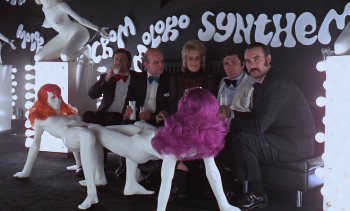 | 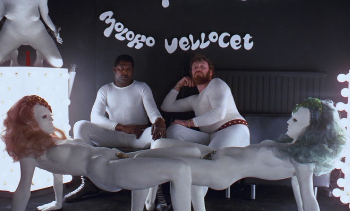 |
Shot 89 | Shot 90 |
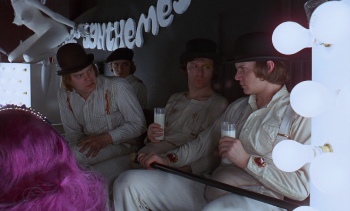 |  |
Shot 91 | Shot 92 |
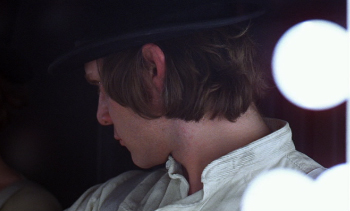 | 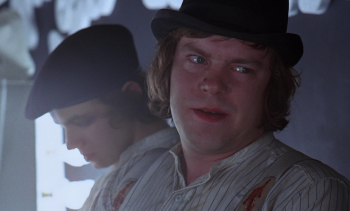 |
The full text of what the woman sang is:
Joy, beautiful spark of the gods,
Daughter of Elysium,
Touched with fire, to the portal,
Of thy radiant shrine, we come.
Your sweet magic frees all others,
Held in Custom's rigid rings.
All men on earth become brothers,
In the haven of your wings.
So, Dim, protesting he's no longer Alex's brother, is in contradiction of the "Ode to Joy" bringing them all together.
Young Alex is an appreciator of great music, but he's also a sadist. A love of great music, or an appreciation of so-called culture, going against traditional creed, does not make for a civilized, empathetic, compassionate human being. It may make for one better educated in what has been determined to be culturally valuable by society, what is thus thought of as "civilized" when "civilization" is the dominant gang, but it doesn't elevate from the bestial to the betters, nor does it make the betters not bestial.
It would be difficult to come up with a quote that best describes the political history of Beethoven's 9th, its heroic declaration of brotherhood and unity of spirit used by different people with different agendas, such as in Nazi Germany where it stirred and confirmed the passions for Aryan superiority and nationalism.
The one thing that all these interpretations have in common is that they great the Ninth Symphony as a cultural symbol of enormous importance. It had already acquired this symbolic value by the time it became established in the repertory, around the middle of the nineteenth century. Schumann's Beethovenites 'stood there with their eyes popping out, and said: 'That was written by our Beethoven, it is a German work--the finale contains a double fugue--he was blamed for not introducing such forms--but how he did it--yes, this is our Beethoven'". And the same sense of possession attaches to the work today, only the focus has changed from the national to the international. The Ninth Symphony has become one of the great symbols of world unity. What other work could possibly have been chosen for a global concert in which choirs and orchestras in Montreal, Moscow, Geneva, and San Francisco performed together, linked by satellite?
Beethoven: Symphony, Issue 9, by Nicholas Cook
Only in the film, not in the book, a mannequin is called by name as Lucy, perhaps bringing in a reference to the angel of light, Lucifer, which actually derives from "morning star" of Venus and, more literally, light-bringing, as in a carrier of light, one who ferries light, introducing the light of dawn. Lucifer, however, is commonly thought of as a fallen angel (the Hebrew MLAK is a messenger, such as an angel of god), and soon Alex's correction officer will ask him what devil crawls up inside him.
I noted earlier how the sculptures of these women on the pedestals studded by protruding light bulbs reminded me of the many-breasted Diana. There was too a Diana Lucifera, "Diana, Bringer of Light". These statues on their pedestals fulfill both aspects, the many-breasted one flowing with milk, and the bringer of light.
For Alex, these Dianas of milk and light bring ultra-violence. Beyond violence. One can't help but think too of ultra-violet, light rays invisible to the naked eye but of which people are aware by their effects.
Lucy works hard. Who else works hard? Jack of The Shining of course. But so too does Bill in Eyes Wide Shut. Light corresponds with knowledge and Bill is given as a knowledgeable doctor, but it's said he works too hard and has missed much, for which reason he is taken to where the rainbow ends.
The hidden dual blackboards observed at HOME lead one to look a little more closely at the sets thus far.
There were no windows in the milk bar, it was an entirely interior space separated from the outside world. The tunnel in which the bum was encountered had at first the same subterranean feel; though an entrance was revealed, an exterior light and the night eclipse the rest of the world. From this tunnel, we went next to the casino which had a rather unnatural and undefined bright white light source exterior the room. I have read that the windows of the Karsino ballroom-theater, where this was filmed, looked out on a lawn. The windows that were on screen right as Alex and his droogs fled the building are clearly visible to the right in this photo of the ballroom that appears to have been taken while it was daylight outside, and they are lit with the sun. Kubrick's rendering of the ballroom is instead done in such a way that we can't begin to parse what is going on with this area as we've no idea from where the bright light proceeds when it is night and the droogs exit through a dark doorway. So, again we have an interior space that is effectively cut off from the exterior and boundaries between the two curiously blurred.

HOME has correspondences with the bar, however different they appear, the bar lit with numerous exposed bulbs fronting the pedestals upon which the chained milk maidens kneel, while HOME is decorated with magnified versions of these same bulbs, each having its own pedestal, their theatrical nature exposed in their relationship to the windows where we begin to recognize the lamps as resembling stage lights. This theatricality was already hinted at in the bar and its resemblance to a black box theater, and the "stage" for violence further established with the casino. It is at HOME where the theatricality is perhaps most fully realized, the stage lights blazing bright and big while Alex performs his song-and-dance routine on the home stage and the literary stage of the writer's desk.
When we first saw HOME's interior, with the deep and narrow space, we had the tunnel like effect of the bar and the concrete tunnel in which was the bum, no windows viewed in either of the long parallel rooms, nor any windows in the entry. HOME is presented as an isolated haven, the large garden painting aspiring even toward a tranquil Eden. The prior sets, beginning with the black box of the milk bar, had been dark and with the bum and the casino we'd had stark contrasts in light and shadow. HOME is instead a bright white with no hint of dark until Alexander's wife goes to the foyer to answer the door, which is when the black and white tiled floor is observed spreading out for an infinity via the mirrors--and I think it's appropriate to view in it a standard association with duality. It is after the introduction visually of dualism via the tiled floor, with the entry of the droogs, that we shift to an oppositional view of the rooms and see that at the front of each is a wall which is all windows, several panes of deep black set in white frames. Though we, the audience, move about the stage with the camera, the large stage lights reflected in the windows suggest that we are also beyond the black windows where the audience would be seated in a theater, in the dark.
The black windows in their white frames also in some ways have a correspondance with the uncovering of the hidden blackboards that we only see after Alex topples the bookcases. Just before Alex topples the desk we're given a brief view of its front. We think of the desk as white because it has a white top and the rooms are white, yet the front of the desk is composed of two black panels. We have a left cabinet and a right on which the top of the desk is set, and both to the rear are white but are flat black on the front. These dual flat black panels anticipate the blackboards that are revealed after the flipping of the desk and the toppling of the shelves. There is nothing written on the black panels of the desk, though the desk of course is where words are produced, ideas thrashed out. The hidden blackboards are grayed by spent chalk and erasure, and have on the left an arrangement of squares while on the right are spirals. We have a split here with sharp angles on the screen left board, boxes and boxes, while the screen right blackboard is spirals. Between them there appears to be an X. Having revealed all this, Kubrick returns us to the Korova Milk Bar where we can examine the bar afresh, the writing on its walls, white on black, much like a blackboard, and itself being a stage on which the woman sings the "Ode to Joy" and Alex berates Dim for not behaving appropriately as a reverental member of the audience.
These scenes form a kind of story architecturally, one building upon the other, from which Kubrick breaks away when we next go to Alex's home. Its feel, however outrageously decorated, is of a fairly standard apartment. But one is made alert to boxes verses circles and story existing not only in action and dialogue but environmentally.
Skybreak is the name of the house that serves as set for HOME, at leasts its interior, in which the elder Frank Alexander lives. It was designed by a group of architects called Team 4, one of whom was Su Brumwell. Their first project was a house called Creek Vain, the home of Su's parents, Marcus and Irene. Marcus and Irene sold a painting for it and the house was built between around 63 and 66. They then did Skybreak in Radlett, Hertfordshire in 65 and 66.
The painting that the Brumwells sold was B277 by Piet Mondrian, done in the year 1937. One blue rectangle in a grid of black and white. (The below two Mondrian photos are from this website which has more info on their provenance.)

B278 has nothing to do with the story, but I'm supposing it was done after B277 and it is has two red rectangles in a grid of black and white.

Incidentally, what's really interesting to me is that Piet Mondrian didn't begin his grid paintings until 1919 and Frank Lloyd Wright was already doing them in stained glass. I wonder if that peeved Wright.

Alex Coonley Playhouse Window by Frank Lloyd Wright
Photosource: franklloydwright.tercenim.com
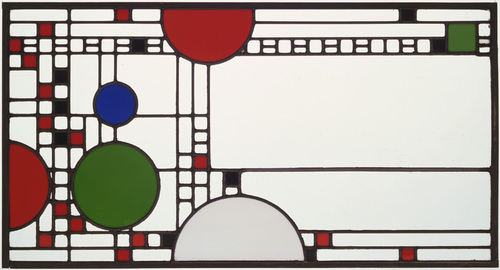
Photosource: Alex Coonley Playhouse Window by Frank Lloyd Wright, 1912.
Photosource: MOMA
The architects who designed Skybreak came over to America previously and went around studying Wright's architecture.
Mondrian was suddenly public pop art big in 1966 with Yves St. Laurent's dresses. Art blending with fashion.
It occurred to me, as I was looking at the Mondrian paintings, that here we have the opening credits of A Clockwork Orange. This extreme color blocking. If the camera zoomed out one may very well find the red and blue of the opening frames situated in grids. Or one may find Alex's blood spilling out of the grid of a wall of white painted bricks.
Later in the film, via the prison yard, Kubrick intentionally brings in Van Gogh's study of Gustave Dore's prison yard painting, done in 1890 while he was Saint-Paul-de-Mausole asylum in Saint Rémy. We have, with the black chalkboard in the Skybreak house, Kubrick playing with this grid linearity against circularity (which is why the Mondrian story interests me), the circularity expressed in the Van Gogh painting that plays into Kubrick's deja vu and perpetual repetition. But linearity is also, in the film, expressed as stultifying, so it's not as if one is being favored over the other. Order is not rising above disorder. Organization does not rise above chaos.

Gustave Dore's Newgate Exercise Yard, 1872.

Van Gogh's Prisoner's Exercising (or Prisoner's Round),
his study of Gustave Dore's Newgate Exercise Yard.

Kubrick's realization of The Prison Yard.
With the way the sky is shown in the Kubrick image of the prison yard, one wonders if there is a connection with the Skybreak house.
Speaking of The Shining, Kubrick explicitly mentioned a Wright designed bathroom in Phoenix (presumably the Biltmore) as inspiration for the bathroom, the flat and bold red of which returns us to the startling red of the Clockwork Orange opening credits.
I discuss in the Wednesday Part 2 section of The Shining analysis whether a Wright bathroom inspired this bathroom, though I do believe it's possible the Biltmore Gold Room influenced the Overlook's Gold Room. The thing that interests me is that Kubrick, in connection with this bold treatment of the red, brings in a Wright story.
Anyway, just a few thoughts.
Approx 16,000 words or 32 single-spaced pages. A 123 minute read at 130 wpm.
Next: Go to Part 2
Go to Table of Contents of the "A Clockwork Orange" analysis
Link to the main TOC page for all the analyses